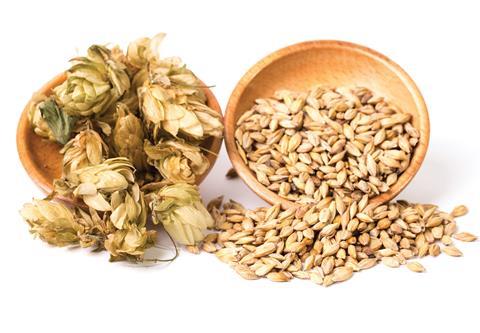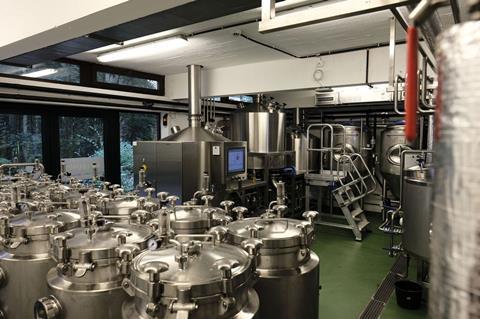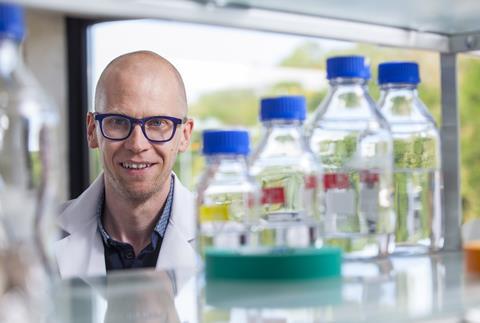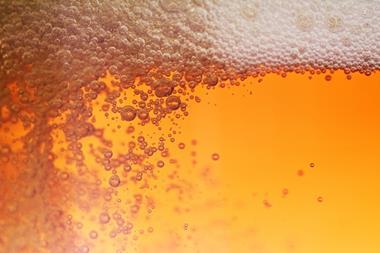Andy Extance goes on tour in the UK and Belgium and compares the science behind the different processes used by craft and mass brewers
To get the best beer flavours ‘you don’t want too many lead singers’, explains Jaega Wise, head brewer at the up-and-coming London, UK, microbrewery Wild Card. Her metaphor reflects a unique perspective: while her day job exploits her chemical engineering training, she twilights as a session singer. So, if Wise wants a particular flavour to belt out like Beyoncé, she arranges other ingredients as backing. Tuning biochemical processes brings out the compounds responsible for the sensory high notes of each ingredient in turn.

When Wise ditched her previous job as a chemical trader in 2012, she and her fellow Wild Card founders liked the sound of making beer a career. Having built on their enthusiasm for ale and home brewing experience, today the company is becoming renowned for innovative drinks such as Unite Local Rhubarb Pale Ale. Flavoured almost entirely by rhubarb, it’s earned accolades even from people who don’t normally like beer.
Wild Card is also part of a recent surge in craft beer’s popularity, with many small producers now starring alongside international drinks giants. All of these brewers face the same chemical and biological challenges. But, the processes used at each end of the scale can reflect discordant outlooks.
On an anarchic Walthamstow industrial estate, inside the whitewashed brickwork and corrugated steel of Unit 8, is Wild Card’s brewery–bar. Here, Wise and her colleagues start the process of making beer by heating water to around 77˚C. They then transfer the water to a steel ‘mash tun’ tank and add malted barley, or malt. This creates the mash that, after filtering, becomes the wort that yeast feed on, fermenting sugars from the barley to become alcohol. Ensuring this process provides yeast with its ideal meal means getting the chemistry just right.
The chemical composition of the water used in the mash is vital, Wise explains. Burton in the UK, for example, spawned the ‘pale ale’ because the high level of sulfates in its local water releases more flavour from hops. The pH of the water matters too. The malting process involves roasting the barley, which produces compounds such as organic acids. Darker, maltier beers therefore need more alkaline water to neutralise the extra malt acidity. Lighter lagers need less alkaline water, like that in Pilsen (home of pilsner) in the Czech Republic.

Flavour factors
London’s highly alkaline water therefore makes brewing lager ‘really challenging’, while making a dark, malty porter beer is ‘beyond easy’, Wise says. ‘A porter practically makes itself,’ she jokes. For India pale ale, she adds a mixture of calcium sulfate, sodium chloride and calcium chloride to the mash tun to ‘Burtonise’ the water.
The malt Wild Card uses – Maris otter – is one of its reliable backup singers. Malt contains starch carbohydrates and enzymes that break the starch down into small sugar molecules, which the yeast then feeds on. Water temperature is key to controlling which sugars form, and how much. Wise explains that Maris otter is a tasty, sturdy base, but not the fastest to break starches into sugars.

‘The choice of good malt is the brewers’ first critical decision,’ says University of Porto, Portugal, chemist Luis Guido. That’s partly because beer flavour changes as it ages and malt contains lipoxygenase enzymes that influence that process, he explains. Lipoxygenase degrades fats producing a ‘staling aldehyde’ called (E)-2-nonenal. The aldehyde brings what Guido calls ‘the unpleasant cardboard flavour of aged beers’. Guido and colleagues have found that lipoxygenase produces approximately 25% of the total (E)-2-nonenal found in the wort during barley roasting. His team consequently recommends tweaking the roasting process to minimise its formation.1
After adding the malt and hot water to the mash tun, the Wild Card brewers leave it for 80 minutes. They then ‘sparge’ the mash: adding hot water to destroy the malt enzymes and prevent them converting any further starch to sugars. The brewers can then filter off the malt, leaving just sweet wort liquid. ‘Then that goes into our kettle, which is boiled for 90 minutes,’ Wise says. ‘As soon as we see any boiling, we add our first hop.’

Standing near a similar mash tun in a research brewery in Ghent, Belgium, Barbara Jaskula-Goiris notes that while boiling hops creates some essential beer flavours, inconsistency can be an issue. She works at the Catholic University (KU) of Leuven’s campus in Ghent, a site that collaborates with almost all the Flemish breweries. Jaskula-Goiris has been studying how heat changes hop compounds known as alpha acids, which include humulone and cohumulone.
‘Alpha acids are not bitter,’ Jaskula-Goiris explains. ‘During the brewing process, especially in the wort boiling, they are isomerised to iso-alpha acids, which are responsible for 90% of beer’s bitterness. But there is a problem. The isomerisation during wort boiling is variable and never complete.’ Therefore sometimes a beer is not bitter enough. To circumvent this issue larger breweries often add ready-prepared iso-alpha acids, produced by companies like the UK’s Botanix. In the Ghent brewery, Jaskula-Goiris’ team also mostly uses such extracts to add bitterness to their beers instead of boiling hops. That option is also open to smaller brewers, but they’re usually more open to a little variation.

Adding the hops at different points in the process introduces even more potentially pleasing complexity. Wild Card’s brewers add hops several times during boiling, sometimes alongside other ingredients such as rhubarb. Next, they put the wort through a heat exchanger to crash cool it to around 20˚C, forcing partially soluble substances to quickly precipitate out. Finally, they filter the wort and transfer the clear liquid to the fermenter, where they add yeast and leave the beer to brew for a few days before bottling.
Wild Card often uses ‘dry hopping’ as well, adding hops at various points after the wort has cooled. That may seem hopping mad, but there is an important reason. ‘Aroma compounds are very volatile,’ Wise explains. ‘Get them anywhere near heat and they completely dissipate.’
Let’s go to the hop
Dry hopping is a risk only craft brewers are usually prepared to take. In doing so, they could be adding microbes or chemicals that could damage the beer during storage. ‘Craft brewers deal with it by having super-short shelf life,’ Wise says. ‘You can have a beer with maximum flavour, but stick a six or nine month shelf life on it.’ Bigger brewers focused on exporting, where beers spend a long time in transit and storage, need a two year shelf life, she adds. ‘Their beer has to be filtered to within an inch of its life.’
Capturing the elusive flavoursome compounds Wise covets has been the purpose of much of the career of Filip Van Opstaele, Jaskula-Goiris’ colleague in Ghent.2 ‘Hop essential oils consist of more than 400 different compounds,’ he says. There are three major classes: terpene hydrocarbons (the most common); oxygen-containing compounds; and the most important for hop aroma, sulfur-containing compounds. Among the oxygenated compounds monoterpene alcohols such as linalool, geraniol, β-citronellol, and esters such as isobutyl isobutyrate and isoamyl isobutyrate are especially important. Differences in levels of these compounds between hop varieties are responsible for much aroma variation.

But more recently, otherwise rare sulfur compounds have come to the fore in hops grown in the US, such as Mosaic and Citra. The US hops have very high geraniol levels, but also contain specific sulfur compounds, Van Opstaele explains while handing over a glass of KU Leuven’s house beer, Sur plus. The most important sulfur compound is 4-methyl 4-sulfanyl-2-pentanone (4-MSP),3 which is so potent that we can smell just a few molecules of it among a trillion other gas molecules. ‘It typically has a tropical fruit scent, but it depends on the concentration,’ Van Opstaele says. ‘When the concentration gets too high you can have blackcurrant and even cat urine. If you prepare it to do analysis with then you have a smell of urine in the whole building.’
Van Opstaele warns that the details of which substances are responsible for typical flavours still aren’t completely understood. ‘A lot of research is going on to find flavour active compounds, and there’s always interplay between multiple compounds,’ he stresses. And things get even more complex thanks to the final major player in beer’s flavour ensemble, yeast.
Yeast’s role in beer flavour is the most underestimated of any ingredient, says Kevin Verstrepen from the Flemish Institute of Biotechnology (VIB) and KU Leuven centre for microbiology. Its contribution is obvious on the opening of a temperature-controlled cabinet containing small fermentation bottles in Verstrepen’s lab, which is actually based in Leuven, not Ghent. There’s a burst of fruity smells from acetate esters such as isoamyl acetate, yeast’s main contribution to beer flavour, the genetics of which Verstrepen’s team studies. Exactly the same esters are responsible for the aromas of apples, bananas and other fruits, he says.
Origin unknown
Verstrepen’s team works with many Belgian and international brewers to develop new brewing yeasts. ‘Usually collaborators want certain aromas and characteristics from the yeast, and they also want to make more money,’ Verstrepen says. ‘We try to provide both.’ Most long-established brewers rely on a single yeast ‘master strain’, he explains. ‘Often they don’t know where it came from or why they’re using that strain.’ And because it’s not a perfect yeast strain, they have to work harder than would otherwise be necessary to make a decent beer.
Yeast is arguably the best-known genome in the world
Kevin Verstrepen, Flemish Insitute of Biotechnology
That loyalty to archaic microbes seems especially strange considering that brewer’s yeast is used widely in biology as a model for human cells. ‘It’s arguably the best-known genome in the world,’ Verstrepen says. Just two genes are responsible for the fruity esters, for example, and they both code for almost exactly the same enzyme, he explains. ‘You can delete one gene and you reduce those flavours; delete both and they’re almost completely gone.’
Verstrepen believes wild yeasts developed these genes to attract fruit flies that would act as ‘taxis’, picking up the yeast and moving it to another sugar source. That argument is supported by tests they’ve done showing flies are only attracted to yeasts with the genes needed to produce fruity aromas.4 The findings have uncomfortable implications for anyone forming wild yeast starters by leaving containers holding cereal and water open to air, thinking yeasts are passively drifting to their aid. That includes Belgium’s Lambic brewers and bakers of sourdough breads. ‘There is the myth that many of the yeasts are floating around in the air,’ Verstrepen stresses. ‘The infection from the outside is insects more than air.’
Domesticated beer yeasts also notably have more genes for transport proteins, which bring nutrients such as wort sugars into their cells so that they can grow more quickly. Such changes have evolved through history, even before humans knew microbes existed, as brewers retrieved ‘ferment’ from the end of one batch to use in the next.
Wild Card doesn’t currently reuse its yeast because it doesn’t have the microscope necessary to inspect the yeast cells and ensure they’re healthy enough to use in another batch. And today even large brewers have halted evolution by regularly resetting their yeast to a reference version.

Air of the dog
Verstrepen’s lab serves as a repository for the reference yeasts for many companies, spanning beer, wine and biofuels, kept at –80˚C in its deep freeze. That gave his team a unique opportunity to sequence 160 domesticated and wild strains to create a genetic family tree.5 Unsurprisingly, while the yeasts are still the same species, domesticated yeasts are genetically completely separate from wild yeasts. ‘They’ve really now adapted to the human-made environment, much like dogs,’ Verstrepen says. For example, selection has crippled genes producing a molecule called 4-vinyl guaiacol, which is responsible for a smoky, clove-like off flavour.
On behalf of large lager brewers, Verstrepen’s team is now accelerating selection. Today, lagers are made stronger than they’re sold, then diluted, for maximum brewing efficiency. ‘But it can only go so far,’ Verstrepen says. ‘Beer yeast can often not withstand higher levels of alcohol, or the flavour starts going wrong.’ Verstrepen and his colleagues are therefore evolving yeast in bioreactors with gradually increasing ethanol content, and studying and cultivating the survivors further.6

The team has also worked on yeasts for lower-strength beer. This is becoming more popular, Verstrepen notes, with low-alcohol beers promising to minimise potential harms while retaining health benefits. Some benefits come because wholegrain cereals are the major source of silicon, which is essential to bone health, observes Porto’s Luis Guido. ‘Beer, then, is not surprisingly a major contributor to silicon intake in the Western diet,’ he explains. Guido adds that beer contains polyphenol antioxidants, albeit less than in wine. However, our ability to absorb them ironically requires a higher alcohol content.
The idea of health-giving beer also sometimes rings false because some brewers consider polyphenols a nuisance, according to Jaskula-Goiris from the Ghent lab. Polyphenols can aggregate with proteins to form colloids that make beer cloudy over time. To prevent this, some brewers add and then filter out solid absorbents that remove polyphenols. Others use less hops to avoid the polyphenols they contribute, replacing the flavour sacrificed with products like polyphenol-free iso-alpha acid extracts.
But, as with dry hopping, any storage benefit seems to come at the detriment of beer’s overall sensory melody. In experiments, Jaskula-Goiris found that beers with polyphenolic extracts usually had a fuller feel in tasters’ mouths.7 Also, ‘the bitterness was far more harmonious in comparison with beers that these polyphenolic extracts were not added to’, she says. Clearly – or perhaps cloudily – there’s a lot to consider in getting all the players in Wise’s metaphorical beer band to strike the right chord.
Andy Extance is a science writer based in Exeter, UK
References
1 D Carvalho, L Gonçalves and L Guido, Compr. Rev. Food Sci. Food Saf., 2016, 15, 927 (DOI: 10.1111/1541-4337.12218)
2 M Dresel et al, BrewingScience, 2015, 68, 8
3 T Praet et al, BrewingScience, 2014, 67, 183
4 J F Christiaens et al, Cell Rep., 2014, 9, 425 (DOI: 10.1016/j.celrep.2014.09.009)
5 B Gallone et al, Cell, 2016, 166, 1397 (DOI: 10.1016/j.cell.2016.08.020)
6 K Voordeckers et al, PLoS Genet., 2015, 11, e1005635 (DOI: 10.1371/journal.pgen.1005635)
7 K Goiris et al, J. Am. Soc. Brew. Chem., 2014, 72, 135 (DOI: 10.1094/asbcj-2014-0327-01)













No comments yet